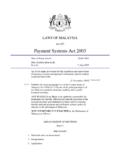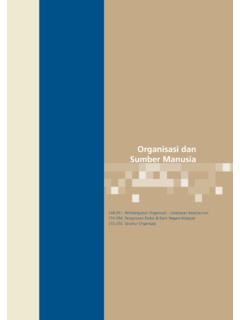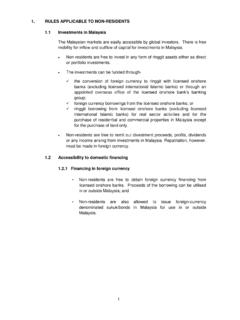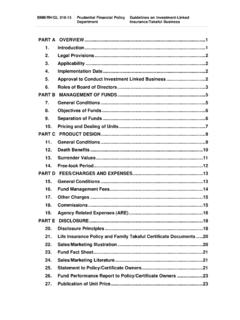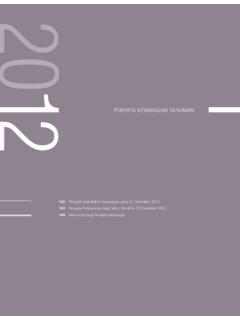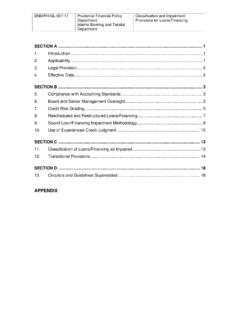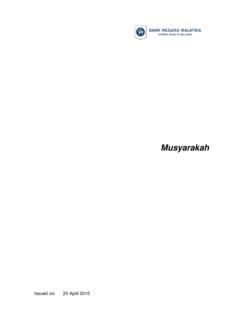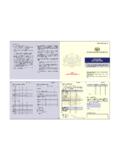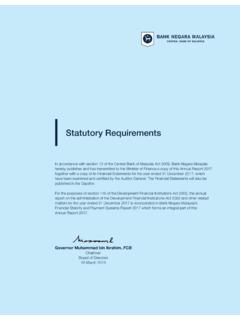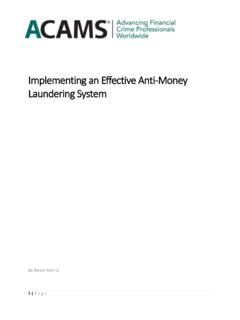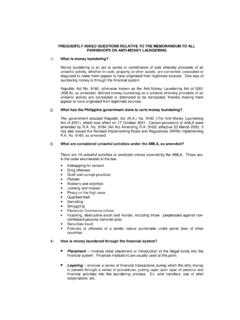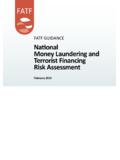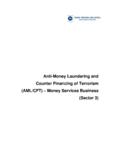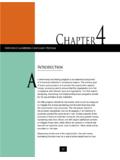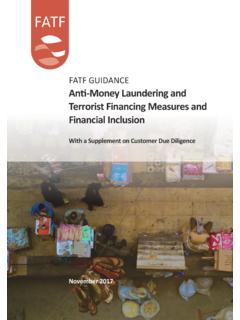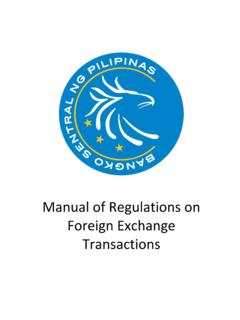Transcription of Anti-Money Laundering and Counter Financing of Terrorism ...
1 Anti-Money Laundering andCounter Financing of Terrorism (AML/CFT) Electronic MoneyandNon-Bank Affiliated Charge & Credit Card(Sector 4)Table of ContentsPART with Existing and BAML/CFT to Foreign Branches and Approach DueDiligence (CDD).. Exposed Persons (PEPs).. Products and Business or Value Transfer Services (MVTS).. on Third Face-to-Face Business Risk to Satisfactorily Complete Information Compliance Transaction the Financing of EnforcementDepartmentAnti- money Laundering and CounterFinancing of Terrorism (AML/CFT) Electronic MoneyandNon-BankAffiliated Charge & Credit Card(Sector 4)Page1of 64 PART Laundering and terrorismfinancing(ML/TF) continues to be anon-going threat which has the potential to adversely affect the country sreputation and investment climate,which may lead to economic andsocial consequences.
2 The globalisation of the financial services industryand advancement in technology has posed challenges to regulators andlaw enforcement agencies as criminals have become moresophisticated in utilising reporting institutions to launder illicit funds anduse them as conduits for ML/TF the formationof theNational CoordinationCommitteeto CounterMoney Laundering (NCC), efforts have been undertaken to effectivelyenhance the AML/CFT compliance framework ofreportinginstitutionsresulting in the introduction of theStandardGuidelines on anti -MoneyLaundering and Counter Financing of Terrorism (UPW/GP1) and therelevant Sectoral Guidelines. While these efforts have addressed theML/TF risks and vulnerabilities, there is a need to continuously assessthe effectiveness of our AML/CFT framework to ensure that it continuesto evolve in line withdevelopments ininternationalstandardsand theglobal to2012, the Financial Action Task Force (FATF) undertook acomprehensive review of the 40+9 Recommendations, which aimed atbringing theRecommendationsmoreup-to-date with the evolvingfinancial, law enforcement and regulatory environment besidesaddressing new and emerging threats.
3 The 2012 revision, theInternational Standards on Combating money Laundering and theFinancing of Terrorism & Proliferation(FATF 40 Recommendations),BNM/RH/STD029-2 FinancialIntelligenceand EnforcementDepartmentAnti- money Laundering and CounterFinancing of Terrorism (AML/CFT) Electronic MoneyandNon-BankAffiliated Charge & Credit Card(Sector 4)Page2of 64sought to clarify and strengthen many of its existing obligations as wellasto reduce duplicationintheRecommendations. One of the newRecommendations introduced is on the obligation of countries to adopta risk-based approach in identifying, assessing and understanding thecountries ML/TF risks,which places further expectationon reportinginstitutionsto assess and mitigate ML/TF on the foregoing paragraphs, reporting institutions mustconduct their business in conformity with high ethical standards andbeonguard against undertaking any businesstransaction that is or may beconnected with or may facilitate ML/TF.
4 These underlying principlesbecome the basis upon which the integrity and soundness of theMalaysian financial system must be formulated in accordance with the provisions of theAnti- money Laundering and anti - Terrorism Financing Act 2001(AMLATFA) and the FATF 40 Recommendations and is intended toensure that reporting institutions understand and comply with therequirementsand obligations imposed on out the:(a)obligations of reporting institutions with respect to the requirementsimposed under the AMLATFA;(b)requirementsimposed onreporting institutionsin implementing acomprehensiverisk-based approach in managing ML/TF risks; andBNM/RH/STD029-2 FinancialIntelligenceand EnforcementDepartmentAnti- money Laundering and CounterFinancing of Terrorism (AML/CFT) Electronic MoneyandNon-BankAffiliated Charge & Credit Card(Sector 4)Page3of 64(c)rolesof the reporting institutions Board of Directors and SeniorManagement (or its equivalent) in putting in place the relevantAML/CFT issued pursuantto:(a)Sections 13, 14, 15, 16, 17, 18, 19, 20, 66E and 83 of theAMLATFA;(b)Section 47(1)and in particular, Paragraph 47(2)(h) of the FinancialServices Act 2013(FSA);(c)Section 57(1) and in particular, Paragraph 57(2)(h) of the IslamicFinancial Services Act2013(IFSA); and(d)Section 74 of theMoney Services Business Act 2011(MSBA).
5 Document is applicable to:(a)reporting institutions in the First Schedule to the AMLATFA:(i)issuers of charge cards and credit cards which are notaffiliatedwith any licensed bank under the FSA, any licensedIslamic bank under the IFSA and prescribed institutionslicensed under the Development Financial Institutions Act2002 (DFIA);(ii)issuers of electronic money , a designated paymentinstrument as prescribed intheFinancial Services(Designated Payment Instruments) Order 2013;(iii)issuers of electronic money who are also licensed as moneyservice business under MSBA;and(iv)any other persons as specified by Bank Negara Malaysia:BNM/RH/STD029-2 FinancialIntelligenceand EnforcementDepartmentAnti- money Laundering and CounterFinancing of Terrorism (AML/CFT) Electronic MoneyandNon-BankAffiliated Charge & Credit Card(Sector 4)Page4of 64(b)branches and subsidiaries of reporting institutions referred to (a); and(c)all products and services offered byreporting institutions referred (a).
6 Reporting institutions are subject tomore than one documentrelating to AML/CFT matters issued pursuant to section 83 of theAMLATFA,the more stringent requirementshall into effect to the requirements outlined in this document shall takeeffect immediately, unless otherwise specified byBank :(a)theStandard Guidelines on Anti-Money Laundering and CounterFinancing of Terrorism (AML/CFT)(UPW/GP1)issued in November2006(amended February 2009);(b)the Anti-Money Laundering and Counter Financing of Terrorism (AML/CFT)Sectoral Guidelines4forNon-Bank Affiliated Chargeand Credit Card Issuers(UPW/GP1[4]) issued inApril2007; and(c)the Anti-Money Laundering and Counter Financing of Terrorism (AML/CFT) Sectoral Guidelines 9 for Electronic money Issuers(UPW/GP1[9]) issued in August EnforcementDepartmentAnti- money Laundering and CounterFinancing of Terrorism (AML/CFT) Electronic MoneyandNon-BankAffiliated Charge & Credit Card(Sector 4)Page5of with Existing be read together with other documents issued byBank Negara Malaysiarelating to compliance with and terms and expressions used in this document shall have the samemeanings assigned to itunder the AMLATFA, FSA and IFSA, as thecase may be, unless otherwise defined in this the purpose of thisdocument: accurate Refers toinformation that has been verified for accuracy.
7 Beneficial owner Refers to any naturalperson(s) who ultimately owns orcontrols a customer and/or the natural person on whosebehalf a transaction is being conducted. It also includesthose natural persons who exercise ultimate effectivecontrol over a legal person or to ultimately owns or control or ultimateeffective control refers to situationsin which ownership orcontrol is exercised through a chain of ownership or bymeans of control other than direct EnforcementDepartmentAnti- money Laundering and CounterFinancing of Terrorism (AML/CFT) Electronic MoneyandNon-BankAffiliated Charge & Credit Card(Sector 4)Page6of 64 beneficiary Depending on the context:Intrust law, a beneficiary refers to the person or personswho are entitled to the benefit of any trust arrangement.
8 Abeneficiary can be a natural or legal person orarrangement. All trusts (other than charitable or statutorypermitted non-charitable trusts) are required to haveascertainable beneficiaries. While trusts must alwayshave some ultimately ascertainable beneficiary, trustsmay have no defined existing beneficiaries but onlyobjects of a power until some person becomes entitled asbeneficiary toincome or capital on the expiry of a definedperiod, known as the accumulation period. This period isnormally co-extensive with the trust perpetuity periodwhich is usually referred to in the trust deed as the wire transfer,refers tothe natural or legal person orlegal arrangement identified by the originator as thereceiver of the requested wire clubs, societies and charities, refers to the naturalpersons, or groups of natural persons who receivecharitable, humanitarian or other types of services of theclubs, societies and EnforcementDepartmentAnti- money Laundering and CounterFinancing of Terrorism (AML/CFT) Electronic MoneyandNon-BankAffiliated Charge & Credit Card(Sector 4)
9 Page7of 64 beneficiaryinstitutions Refers to the institution which receives the wire transferfrom the ordering institution directly or through anintermediary institution and makes the fund available tothe beneficiary. Board of Directors Refers to a governing body or a group of directors. Adirector includes any person who occupies a position of adirector, however styled, of a body corporate orunincorporated, and includes in the case of:(a)a corporation, the same meaning assigned to it insub-section 4(1) of the Companies Act 1965;(b)a sole proprietorship, means the sole proprietor; and(c)a partnership, means the senior or equity partners. Core Principles Refersto the Core Principles for Effective BankingSupervision issued by the Basel Committee on BankingSupervision, Objectives and Principles for SecuritiesRegulation issued by the International Organisation ofSecurities Commissions, and the Insurance CorePrinciples issued by the International Association ofInsurance Supervisors.
10 Cover payment Refers to a wire transfer that combines a paymentmessage sent directly by the ordering institution to thebeneficiary institutionwherethe routing of the fundinginstruction (the cover)iscarried out or performedthroughone or more intermediary institutions. cross-border wiretransfer Refers to any wire transfer where the ordering institutionand beneficiary institution are located in differentBNM/RH/STD029-2 FinancialIntelligenceand EnforcementDepartmentAnti- money Laundering and CounterFinancing of Terrorism (AML/CFT) Electronic MoneyandNon-BankAffiliated Charge & Credit Card(Sector 4)Page8of term also refers to any chain of wiretransfer in which at least one of the institutions involved islocated in a different country.
